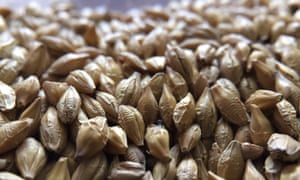“We all know that beer is made with only four natural ingredients: hops, barley, yeast and water,†says Ben Richards, beer sommelier turned home brewer and allotmenteer. “But I think we take them for granted. Until now, I’ve never really known how much work goes into producing those elements.â€
Richards’ plot sits high on a hill, overlooking a valley near his home in east Devon. More familiar with drinking and discussing any of the 12,000 beers now brewed in the UK, his mission now is to discover how you can brew your own beer from scratch, using only what can be harvested, collected or scraped together.
Completely new to horticulture, as well as home brewing, Richards realised early on that he would need help. “While I know my beer, I don’t know my gardening,†he says. “The one rule I’m sticking to is that only items that have been grown or gathered, or originated on the allotment are allowed to go into the final beer. Which means no pesticides and no sprays â€" nothing like that at all.â€
Ben approached There’s A Beer For That for help, knowing it was a campaign with an interest in promoting the quality, diversity and versatility of beer. Recognising a kindred spirit, they leapt on board. Ben began by getting in touch with more heavyweight expertise â€" starting with former Gardeners’ World presenter Toby Buckland. On a two-hour trip to the site, Buckland advised Richards on weeding, tilling, preparing seedbeds and organic pest control. The conversation has been recorded in one of a series of podcasts to be released later in the summer.

“Hops only grow in a couple of bands across the world,†says Richards. “In the UK, that band stretches up from Devon to the middle of the country and has just the right balance of daylight and rain for hops to thrive in.†At the time of writing, there were six healthy-looking plants at waist height threading themselves around a central frame. Toby’s advice is clearly paying off.
“Yeast is the hardest one to do,†says Richards. “Getting and separating the yeast strain needed from the many hundreds that occur naturally is probably beyond the average person.†Taking on this challenge is a team of experts from the University of Exeter, who have agreed to take samples from the leaves of Richards’ hedge to isolate a workable yeast culture to use in the final beer.
In March, Richards’ research led him to Amsterdam to meet the only brewer in Europe currently using rainwater to create beer. Yoris Hoebe is co-founder of Hemelswater, heaven’s water in Dutch, a response to the city-wide campaign to stop the sewers overflowing by reducing the amount of water that reaches them.
“There are a lot of problems with drinking water,†Hoebe told the Guardian when the initiative launched in 2016, “with more drugs and hormones [found in it]. We believe that with rainwater, we can make cleaner beer.â€
The effect of rainwater on the brew will be a key factor in determining the type of beer Richards will produce at the end. “Rainwater is very, very soft,†he says. “There are not many minerals, or salts or deposits like you’d get from spring or mains water, which lends itself to lighter styles â€" blondes or pilsners or light beers, rather than the darker stuff.â€

Other factors influence the style of beer brewed, including the length of time for brewing, the way in which the barley is malted and the choice of hops. “I put in four varieties,†says Richards. ‘Two classic English: fuggles and goldings; a continental one called Perle, which will give you that very slightly peppery flavour used in lagers; and an American one, that gives a much more fruity, citrussy, piney flavours â€" a bit more brash and outspoken than an English hop would be.â€
Richards hasn’t yet decided which of the 140-plus styles his final brew will be. “In one of my podcast interviews, I’m going to have a chat with a beer writer or sommelier to see what they think,†he says. But first, Richards must prove himself a farmer.
“I did a risk assessment hierarchy the other day,†he says. “When I added up the scores and put it all together, it turns out that the biggest risk by a country mile is me. My lack of experience and my involvement in everything means that I’m most likely to cause a problem.
“But I’ve said all along that if any elements don’t really go to plan, it just highlights how difficult it is for the people who farm, grow or process these ingredients day-in, day-out, to do it consistently and produce the high-quality beer we’re used to in Britain.
“But the further along I go, the more I want it to be as good as it can be.â€
For information about different beer styles or for a perfect beer and food match, visit www.beerforthat.com
Follow Ben’s adventures at growingbeer.co.uk









